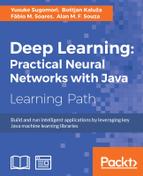A lot of the libraries of deep learning have been developed all over the world. In November 2015, TensorFlow (http://www.tensorflow.org/), a machine learning/deep learning library developed by Google, became open to the public and attracted great attention.
When we look at the programming language with which libraries are being developed, most of them open to the public are developed by Python or use the Python API. TensorFlow is developed with C++ on the backend but it's also possible to write code with Python. This book focuses on Java to learn deep learning, hence the libraries developed by other languages will be briefly introduced in Chapter 7, Other Important Deep Learning Libraries.
So, what Java-based libraries do we have? Actually, there are a few cases that are actively developed (perhaps there are also some projects not open to public). However, there is only one library we can use practically: Deeplearning4j (DL4J). The official project page URL is http://deeplearning4j.org/. This library is also open source and the source code is all published on GitHub. The URL is https://github.com/deeplearning4j/deeplearning4j. This library was developed by Skymind (http://www.skymind.io/). What kind of library is this? If you look at the project page, it's introduced as follows:
"Deeplearning4j is the first commercial-grade, open-source, distributed deep-learning library written for Java and Scala. Integrated with Hadoop and Spark, DL4J is designed to be used in business environments, rather than as a research tool. Skymind is its commercial support arm.
Deeplearning4j aims to be cutting-edge plug and play, more convention than configuration, which allows for fast prototyping for non-researchers. DL4J is customizable at scale. Released under the Apache 2.0 license, all derivatives of DL4J belong to their authors."
When you read this, you will see that the biggest feature of DL4J is that it was designed on the premise of being integrated with Hadoop. This indicates that DL4J suits the processing of large-scale data and is more scalable than other libraries. Moreover, DL4J supports GPU computing, so it's possible to process data even faster.
Also, DL4J uses a library called N-Dimensional Arrays for Java (ND4J) internally. The project page is http://nd4j.org/. The same as DL4J, this library is also published on GitHub as an open source project: https://github.com/deeplearning4j/nd4j. The developer of the library is the same as DL4J, Skymind. As you can see from the name of the library, this is a scientific computing library that enables us to handle versatile n-dimensional array objects. If you are a Python developer, it might be easier for you to understand this if you imagine NumPy, as ND4J is a library inspired by NumPy. ND4J also supports GPU computing and the reason why DL4J is able to do GPU integration is because it uses ND4J internally.
What good can come from working with them on GPUs? Let's briefly look at this point. The biggest difference between CPU and GPU is the difference in the number of cores. GPU is, as represented in its name, a graphical processing unit, originally an integrated circuit for image processing. This is why GPU is well optimized to handle the same commands simultaneously. Parallel processing is its forte. On the other hand, as CPU needs to process various commands, these tasks are basically made to be processed in order. Compared to CPU, GPU is good at processing huge numbers of simple tasks, therefore calculations such as training iterations of deep learning is its field of expertise.
Both ND4J and DL4J are very useful for research and data mining with deep learning. From the next section on, we'll see how these are used for deep learning in simple examples. You can easily understand the contents because you should already understand the core theories of deep learning by now. Hopefully, you can make use of this for your fields of study or business.
